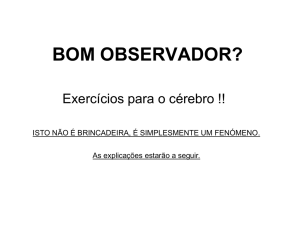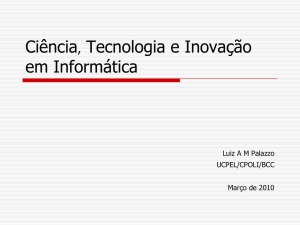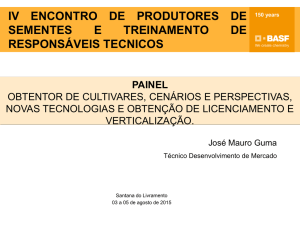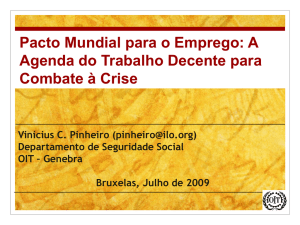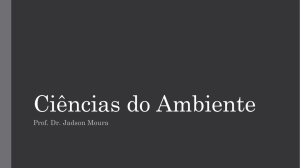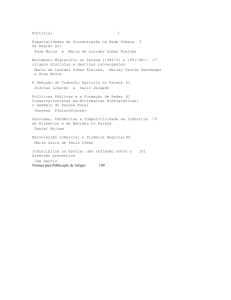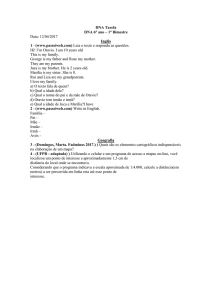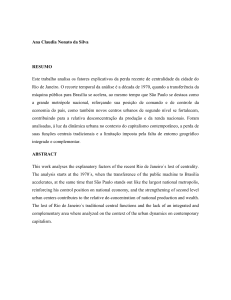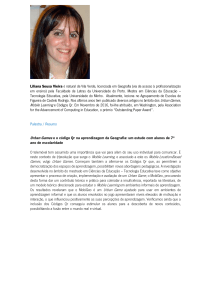Migração e pobreza rural
Propaganda
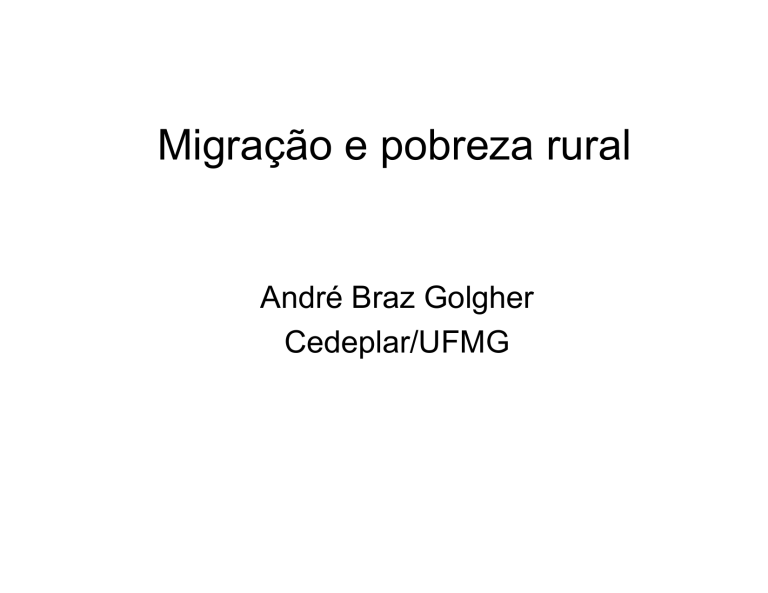
Migração e pobreza rural André Braz Golgher Cedeplar/UFMG Migração e pobreza rural • Pequena parte de amplo projeto sobre pobreza rural no Brasil coordenado por Prof. Helfand, University of California, Riverside • Sobre Migração e pobreza rural foram feitos dois trabalhos preliminares e dois finais. Trabalhos • Migration in Brazil: recent trends • Migration diversity in Brazil: where are the poor people? • The selectivity of migration in Brazil: implications for rural poverty • Migration strategies and income in Brazil: implications for rural poverty The selectivity of migration in Brazil: implications for rural poverty • • • • • • • • Motivação Resumo da metodologia e resultados Dados descritivos Simulação matemática Metodologia empírica Resultados empíricos Simulações com dados empíricos Conclusões Motivação • Níveis de pobreza no Brasil apresentam uma marcante heterogeneidade espacial. • As zonas rurais das regiões Nordeste e Norte têm as maiores proporções de pobres. • A migração de e para áreas rurais podem impactar nos níveis regionais de pobreza, em especial por causa da seletividade da migração. Resumo da metodologia e resultados • Simulações matemáticas, baseadas nos modelos de capital humano e de Roy, foram feitas para discutir a seletividade da migração. • Regressões multinomiais logísticas analisaram empiricamente alguns aspectos dessas simulações. • Foi observado uma tendência geral de seleção negativa para os fluxos rural/rural e uma seleção positiva para fluxos rural/urbano e para migrações longas. Dados descritivos Table 6 - Education level of migrant flows and non-migrants, by type of flow for persons aged 20 and 29 years Mean schooling for persons with age between 20 and 29 (years) North Northeast Southeast South Center-West Type of flow Region Region Region Region Region Rural/urban intrastate 4.97 4.52 6.22 6.97 5.78 Rural/urban between neighbors 5.09 4.11 5.83 6.96 5.92 Rural/urban between non-neighbors 5.95 4.96 5.96 7.22 6.08 Rural/rural intrastate 3.52 2.90 4.47 5.27 4.22 Rural/rural between neighbors 3.54 2.72 4.35 5.37 4.64 Rural/rural between non-neighbors 4.03 3.73 4.65 5.66 4.40 Rural non-migrants 3.71 3.51 5.45 6.05 5.14 Source: FIBGE, 2000. Simulação matemática: motivação Simulação matemática Equação de longo prazo (modelo de capital humano e relação capital humano e salários: t Gij = ∫ (W jt − Wit )e − pt dt − Cij 0 ln(Wi ) = μ i + υ i S Equação de curto prazo: t´ H = ∫ [(Wij ( S ) − E ( S )]dt − C ij 0 Simulação matemática Young adults Adults Human capital 14 13 12 11 10 9 8 7 6 5 4 3 2 Elderly 1 40 35 30 25 20 15 10 5 0 -5 -10 0 G value Diagram 1 – Net returns of migration Simulação matemática Table 11 – Threshold values for H and G functions – changes in a values G>0 Simulations H>0 Young adults Adults Intrastate ≥ 3.0 ≥ 3.0 ≥ 6.0 Interstate between neighbors ≥ 5.2 ≥ 5.2 ≥ 7.2 Interstate between non-neighbors ≥ 11.2 ≥ 11.2 ≥ 11.2 Elderly ≥ 10.4 ≥ 12.2 - Metodologia empírica • Regressões multinomiais logística: ln( Pij Pik ) = X i ´(β j − β k ) = X i ´β j • Objetivo: identificar as variáveis que mudam as probabilidades do indivíduo ser um migrante de diferentes tipos • Dados do Censo Demográfico de 2000. Pessoas com idade entre 18-64 anos. Resultados empíricos Table 13 – Multinomial logistic model – rural/urban flows – North Region Interstate between Interstate between nonIntrastate neighbors neighbors S.D. Odds Coef. S.D. Odds Coef. S.D. Odds Variable Coef. Intercept 3.439 0.0146 2.138 0.0213 0.826 0.0293 Age -0.363 0.0010 -0.363 0.0014 -0.367 0.0019 Age squared 0.004 0.0000 0.004 0.0000 0.004 0.0000 Sex -0.190 0.0060 0.83 -0.106 0.0105 0.90 0.033 0.0140 1.03 Ethic group 0.190 0.0118 1.21 0.910 0.0141 2.49 -0.006 0.0071 0.99 Civil status -0.038 0.0082 0.96 -0.021 0.0150 0.98 0.357 0.0184 1.43 Schooling 0.070 0.0010 1.07 0.067 0.0018 1.07 0.148 0.0022 1.16 ote 1: The results in bold face are not significant at 5%. Note 2: Non-migrant category was the base for comparison. Note 3: -2log(likelihood): with intercept only 828520; and final model 468886. Note 4: number of observations = 1944790. Simulações com dados empíricos Table 23 – Fictitious simulations Simulations and probabilities (%) 4 5 Possibility 1 2 3 Rural/rural intrastate migrant 4.73 2.96 2.63 2.31 1.18 Rural/rural interstate between neighbors migrant 0.86 0.60 0.57 0.57 0.22 Rural/rural interstate between non-neighbors migrant 0.40 0.34 0.39 0.33 0.33 Rural/urban intrastate migrant 5.27 2.35 1.82 0.84 2.18 Rural/urban interstate between neighbors migrant 1.11 0.58 0.50 0.26 0.52 Rural/urban interstate between non-neighbors migrant 1.82 1.35 1.39 1.02 2.37 Migrant 14.2 8.19 7.30 5.32 6.81 Non-migrant 85.8 91.8 92.7 94.7 93.2 1 – Non-White/Asiatic bachelor woman, 24 years old, with two years of formal education 2 – Non-White/Asiatic married woman, 30 years old, with two years of formal education 3 – Non-White/Asiatic married man, 30 years old, with two years of formal education 4 – Non-White/Asiatic married man, 50 years old, with one year of formal education 5 – Non-White/Asiatic married man, 30 years old, with eight years of formal education 6 – White/Asiatic married man, 30 years old, with eight years of formal education 6 1.02 0.18 0.48 1.98 0.52 4.79 8.97 91.0 Conclusões • As simulações matemáticas indicaram que fluxos de longa distância, em particular os do tipo rural/urbano devem apresentar seleção positiva, principalmente devido aos custos de curto prazo. • Foi observado empiricamente uma tendência de seleção negativa para os fluxos rural/rural e uma positiva para fluxos rural/urbano e para fluxos longos Conclusões • A maioria dos indivíduos de baixa renda tem a possibilidade de migrar, mas apenas em etapas curtas e entre áreas rurais. • Políticas que diminuem os custos de migração teriam uma impacto positivo na gama de possibilidades da população de baixa renda.

